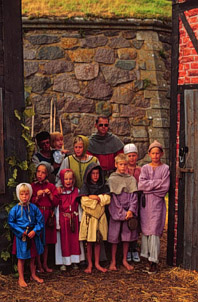Meet the Middle Ages
BackChildren and young people

Children were children during the Middle Ages, just as in all ages. They played, laughed and carried on like all children do. And they were loved by their parents like children always have been.
The children of rich noblemen, kings and princes led somewhat different lives than the other children in town. They had to pass on the family traditions. Their lives were planned from an early age. They had to make a good marriage to keep the power and wealth within the family and preferably to increase it. The parents arranged marriages whilst the children still were young. For example, Princess Margareta (who later became one of the founders of the Kalmar Union) was engaged to be married to the Norwegian King Haakon when she was only six years old. She married him at the age of ten. Her husband was then 23 years old. Another example is Birgitta Birgersdotter, who was only thirteen years old when she married Ulf Gudmarsson. The boys and girls of the nobility were brought up to be leaders, but despite that, they had some time for fun and games, too.
The lives of the children of the craftsmen or merchants were very different. Up to perhaps ten years of age, they were looked at as children. From the time they learned to walk ,till the age of ten, there was a lot of time for fun and games. The town was an exciting place to explore. It was busy and crowded, with ships coming in with foreign goods. The children had time to play and to use their imagination. They told each other exciting and fantastic stories. They learned many tales and legends from the older children.
Most towns had schools. Sons of the craftsmen and the merchants learned to read and write there. Later, they were able to go into business. Some pupils studied to become scribes or priests. In exceptional cases, girls could be educated at a nunnery.
At the age of ten or twelve, the children were introduced into the world of the adults. The son of a craftsman would help in the workshop, the merchant’s son assisted in the loading and stocking of goods. Girls learned how to make clothes from both home-made and foreign cloth. They learned how to cook food for all kinds of occasions - both workdays and. At the age of twelve, one was considered an adult and given more responsibility. Boys and girls usually married at 17-20 years of age.
Read more about children and young people under "Country Life. Workdays and Feasts" and "Society. Life and Death". You can read about schools under "Town Life. Churches, Monasteries and Nunneries", and about tales and legends under "Society. Tales and Pictures".